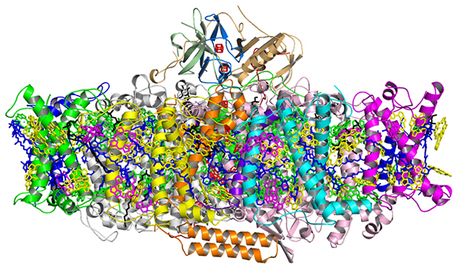The basis for high-efficiency energy transfer in photosynthetic organisms

Chinese and Japanese researchers have resolved the structure of so-called photosystem I (PSI) to a spatial resolution of 0.28 nm and elucidated the mechanisms governing the conversion of carbon dioxide into sugars for high-efficiency energy transfer in photosynthetic organisms.
PSI is one of the two photosystems found in the thylakoid membrane of oxygenic photosynthetic organisms. Its function is to harvest light energy that is utilised to drive a chain of electron transfer reactions, which leads to the production of the reduction power required for converting CO2 into sugars.
In higher plants, the core of PSI is surrounded by a large light-harvesting complex I (LHCI), which forms a PSI-LHCI supercomplex with a total molecular mass of 600 kDa. The light energy captured by LHCI is transferred to the PSI core with extremely high efficiency.
The crystal structure of plant PSI-LHCI supercomplex has been reported previously; however, the crystal structures reported so far lacked sufficient resolution to reveal the detailed organisation of the PSI-LHCI supercomplex with atomic precision, especially with respect to the positions and number of co-factors associated with LHCI. Now, researchers at Okayama University and the Chinese Academy of Sciences have solved the crystal structure of plant PSI-LHCI supercomplex to a resolution of 2.8 Å.
The research group purified and crystallised the PSI-LHCI supercomplex from the leaves of a pea plant and succeeded in improving the quality of the crystals dramatically. With these improved crystals, the group was able to collect the X-ray diffraction data using the intense X-ray at the synchrotron facility SPring-8 in Japan. They then analysed the data using crystallographic approaches to determine the structure.
The improved structure revealed the detailed organisation of protein sub-units and co-factors. This enabled the mechanisms of energy transfer, regulation and photoprotection within the PSI-LHCI supercomplex to be examined on a more robust structural basis.
The team’s work, published in the journal Science, provides structural insights into the energy absorption and transfer mechanisms in photosynthesis. It may additionally provide a blueprint for the design of light-harvesting set-ups with high efficiencies that can be utilised in artificial photosynthetic systems.
Why are young plants more vulnerable to disease?
Fighting disease at a young age often comes at a steep cost to plants' growth and future...
Liquid catalyst could transform chemical manufacturing
A major breakthrough in liquid catalysis is transforming how essential products are made, making...
How light helps plants survive in harsh environments
Researchers from National Taiwan University have uncovered how light stabilises a key...




